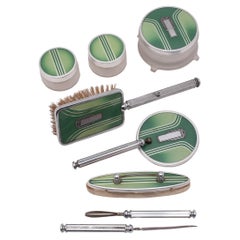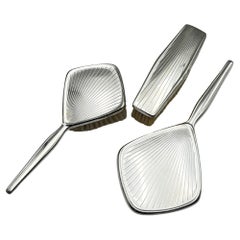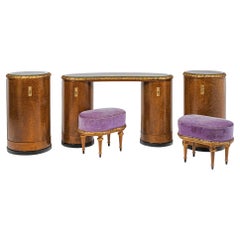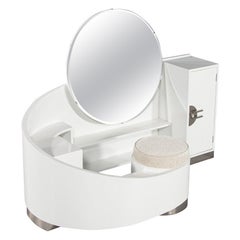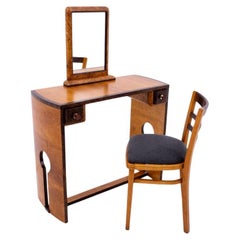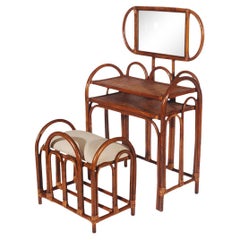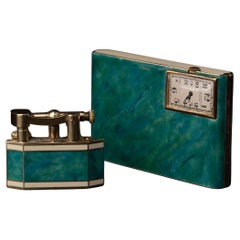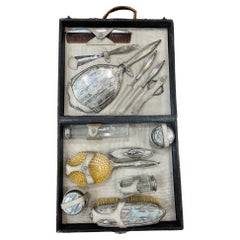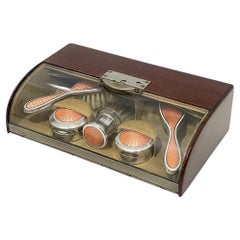Art Deco Vanity Set
Mid-20th Century American Art Deco Historical Memorabilia
Silver, Enamel
Vintage 1930s German Art Deco Sterling Silver
Silver, Silver Plate
Vintage 1930s Austrian Art Deco Night Stands
Wood
Vintage 1930s French Art Deco Vanities
Metal
Vintage 1940s Polish Art Deco Vanities
Walnut
Vintage 1970s American Mid-Century Modern Vanities
Fabric, Rattan, Mirror
Vintage 1920s Art Deco Vanity Items
Gold, Enamel
Early 20th Century European Art Deco Vanity Items
Sterling Silver
Early 20th Century European Toys and Dolls
Silver Plate
Early 20th Century English Art Deco Vanities
Metal, Other
Vintage 1920s French Art Deco Vanity Items
Diamond, Blue Sapphire, Enamel
Vintage 1920s British Art Deco Vanity Items
Sterling Silver
Mid-20th Century English Art Deco Vanity Items
Late 20th Century Art Deco Vanity Items
Late 20th Century French Art Deco Vanity Items
Vintage 1930s British Art Deco Bedroom Sets
Wood
Early 20th Century English Art Deco Vanity Items
Pearl, Silver, Sterling Silver
Mid-20th Century English Art Deco Vanity Items
Gold Plate
Late 20th Century French Art Deco Vanity Items
Gold Plate
Antique Mid-19th Century Art Deco Vanity Items
Late 20th Century French Art Deco Vanity Items
Gold Plate
Antique Early 19th Century Japanese Art Deco Vanity Items
Early 20th Century American Art Deco Vanity Items
Silver, Sterling Silver, Enamel
Late 20th Century Italian Art Deco Vanity Items
Gold Plate
2010s Indian Art Deco Vanity Items
Diamond, Emerald, Jade, Ruby, 22k Gold, 24k Gold
Vintage 1930s Italian Art Deco Bedroom Sets
Silver
Mid-20th Century English Art Deco Bedroom Sets
Mirror, Walnut
Early 20th Century French Art Deco More Mirrors
Bakelite
Early 20th Century European Art Deco Decorative Boxes
Crystal
Mid-20th Century German Art Deco Bottles
Ceramic
Vintage 1920s French Art Deco Crystal Serveware
Crystal
Vintage 1920s English Art Deco Platters and Trays
Crystal, Sterling Silver
Vintage 1930s Austrian Art Deco Glass
Art Glass
Vintage 1930s French Art Deco Jewelry Boxes
Bakelite
20th Century North American Art Deco Sterling Silver
Sterling Silver
Early 20th Century French Art Deco Decorative Boxes
Glass
Early 20th Century British Sterling Silver
Sterling Silver
Early 20th Century Czech Art Deco Bottles
Glass
1950s Italian Decorative Objects
20th Century Czech Art Deco Bottles
Glass
Early 20th Century Art Deco Glass
Silver Plate
Early 20th Century French Art Deco Collectible Jewelry
Silver
Early 20th Century American Art Deco Sterling Silver
Sterling Silver
Mid-20th Century British Art Deco Sterling Silver
Silver
Vintage 1950s Italian Art Deco Glass
Gold Leaf
Mid-20th Century Spanish Art Deco Jars
Alabaster
21st Century and Contemporary Philippine Art Deco Desks and Writing Tables
Brass
Vintage 1930s Belgian More Furniture and Collectibles
Ceramic
20th Century Art Deco Vanity Items
Gold, Gold Plate
Vintage 1920s French Art Deco Vanity Items
Vintage 1930s British Art Deco More Furniture and Collectibles
Glass
Vintage 1930s American Art Deco Collectible Jewelry
Bakelite
Vintage 1920s British Art Deco More Desk Accessories
Enamel
Early 20th Century English Art Deco Bottles
Brass
Vintage 1940s French Art Deco Sterling Silver
Crystal, Gold, Sterling Silver
Vintage 1930s Czech Art Deco Glass
Vintage 1920s American Art Deco Sterling Silver
Sterling Silver
Vintage 1930s French Vanities
- 1
Art Deco Vanity Set For Sale on 1stDibs
How Much is a Art Deco Vanity Set?
Read More
This Onyx, Diamond and Sapphire Ring Is an Art Deco Stunner
The exquisite French jewel feels as modern today as when it was created, nearly a century ago.
Eileen Gray’s Famed Cliffside Villa in the South of France Is Returned to Its Modernist Glory
After years of diligent restoration, E-1027, the designer-cum-architect’s marriage of romance and modernism, is finally complete.
A 1920s Art Deco Necklace with a Stunning Drop Emerald
The cabochon gem centerpiece and diamond-set elliptical rings makes it a marvel of Gatsby-era glamour.
Cartier: The Jeweler Who Helped Define Art Deco
Cartier created some of the most iconic jewelry designs that defined this era.
Our Guide to Victorian, Edwardian and Art Deco Engagement Rings
Learn about these antique jewelry styles, then choose a design that speaks to you.
Why Vintage Watches Are Making a Comeback
Men, women and the watchmakers themselves are falling for the old-fashioned charm of retro timepieces.
The Process: 5 Creators of Chic Customizable Lighting
Bespoke lighting is a hallmark of upscale interiors, and contemporary makers are increasingly ambitious in their materials and forms.
An Incomparable Trove of Art Deco Treasures Is on View in Miami Beach
Heading to Florida for the art and design fairs in early December? Make time on your schedule to visit a newly opened exhibition that examines the movement's migration from Europe to America, and its evolution from niche to universal appeal.
